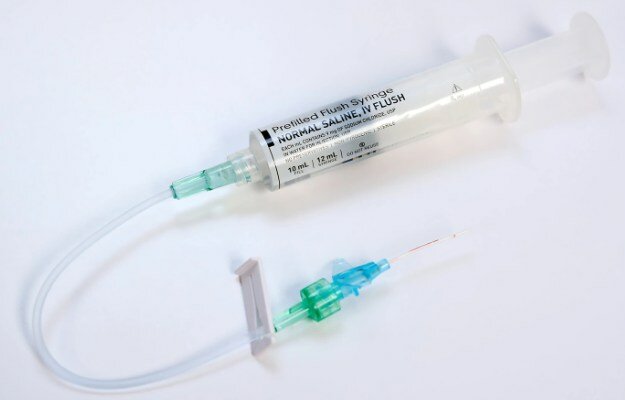Robotic Training System Reduces CVC Placement Complications
|
By HospiMedica International staff writers Posted on 05 Nov 2019 |

Image: Dr. Scarlett Miller demonstrating the prototype haptic robotic training system (Photo courtesy of Shea Winton/ PSU).
An innovative robotic training system diminishes the number of complications associated with central venous catheters (CVC) placement.
Under development at Penn State College of Medicine (PSU; Hershey, PA, USA) and Cedars-Sinai Medical Center (Los Angeles, CA, USA), the dynamic haptic robotic training (DHRT+) system integrates a mixed-reality smart tray, an advanced testing surface, high-fidelity virtual ultrasound imaging, and real-time, adaptive feedback assessment. The haptic system is based on a programmable robot that applies force to the hands of a surgical resident so as to replicate the sensation of inserting a needle into the patient's body.
To prepare surgical residents for the patient diversity they will see in the clinic, the DHRT+ will simulate varying realistic insertion scenarios. The device will provide direct feedback and assessment to users and immediate results on what they did right, what they did wrong, and what skills they need to work on and improve. The robotic training platform will also connect automatically to the centralized DHRT+ global learning system, which will automatically store and analyze performance information and update the DHRT+ simulation to continually improve learning performance.
“The DHRT+ system is focused on not just decreasing and even eliminating the mechanical complications and the training of that, but also looking at the entire procedure, so from the moment that they start consenting the patient to the moment that they insert the final devices,” said Scarlett Miller, PhD, of the PSU department of design and industrial engineering. “By focusing on the process from beginning to end, the team will decrease not only mechanical complications, but also infectious complications, both before and after the central line placement.”
“It's one thing to be really proficient on a simulator, to be fast and accurate, but it's a different thing to say that the learning in the sim center gets translated to the bedside and results in fewer complications, improved safety and less stress on everybody,” said Philip Ng, MD, director of the Procedure Center and Vascular Access Services at Cedars-Sinai Medical Center. “Every case that they do in the sim center should be viewed as learning a different tool they will put in their toolbox so that when they are faced with an actual clinical scenario out there, they can reach into their toolbox, apply what they've learned, and get the right tool for the right job.”
CVCs can be placed in veins in the neck (internal jugular vein), the chest (subclavian or axillary vein), the groin (femoral vein) or through veins in the arm (when they are known as a peripherally inserted central catheter (PICC) line. They can be used to administer medication or fluids that are unable to be taken by mouth or would harm a smaller peripheral vein, obtain blood measurements, such as central venous oxygen saturation, measure central venous pressure (CVP) or for dialysis.
Related Links:
Penn State College of Medicine
Cedars-Sinai Medical Center
Under development at Penn State College of Medicine (PSU; Hershey, PA, USA) and Cedars-Sinai Medical Center (Los Angeles, CA, USA), the dynamic haptic robotic training (DHRT+) system integrates a mixed-reality smart tray, an advanced testing surface, high-fidelity virtual ultrasound imaging, and real-time, adaptive feedback assessment. The haptic system is based on a programmable robot that applies force to the hands of a surgical resident so as to replicate the sensation of inserting a needle into the patient's body.
To prepare surgical residents for the patient diversity they will see in the clinic, the DHRT+ will simulate varying realistic insertion scenarios. The device will provide direct feedback and assessment to users and immediate results on what they did right, what they did wrong, and what skills they need to work on and improve. The robotic training platform will also connect automatically to the centralized DHRT+ global learning system, which will automatically store and analyze performance information and update the DHRT+ simulation to continually improve learning performance.
“The DHRT+ system is focused on not just decreasing and even eliminating the mechanical complications and the training of that, but also looking at the entire procedure, so from the moment that they start consenting the patient to the moment that they insert the final devices,” said Scarlett Miller, PhD, of the PSU department of design and industrial engineering. “By focusing on the process from beginning to end, the team will decrease not only mechanical complications, but also infectious complications, both before and after the central line placement.”
“It's one thing to be really proficient on a simulator, to be fast and accurate, but it's a different thing to say that the learning in the sim center gets translated to the bedside and results in fewer complications, improved safety and less stress on everybody,” said Philip Ng, MD, director of the Procedure Center and Vascular Access Services at Cedars-Sinai Medical Center. “Every case that they do in the sim center should be viewed as learning a different tool they will put in their toolbox so that when they are faced with an actual clinical scenario out there, they can reach into their toolbox, apply what they've learned, and get the right tool for the right job.”
CVCs can be placed in veins in the neck (internal jugular vein), the chest (subclavian or axillary vein), the groin (femoral vein) or through veins in the arm (when they are known as a peripherally inserted central catheter (PICC) line. They can be used to administer medication or fluids that are unable to be taken by mouth or would harm a smaller peripheral vein, obtain blood measurements, such as central venous oxygen saturation, measure central venous pressure (CVP) or for dialysis.
Related Links:
Penn State College of Medicine
Cedars-Sinai Medical Center
Latest Surgical Techniques News
- Minimally Invasive Endoscopic Surgery Improves Severe Stroke Outcomes
- Novel Glue Prevents Complications After Breast Cancer Surgery
- Breakthrough Brain Implant Enables Safer and More Precise Drug Delivery
- Bioadhesive Sponge Stops Uncontrolled Internal Bleeding During Surgery
- Revolutionary Nano Bone Material to Accelerate Surgery and Healing
- Superior Orthopedic Implants Combat Infections and Quicken Healing After Surgery
- Laser-Based Technique Eliminates Pancreatic Tumors While Protecting Healthy Tissue
- Surgical Treatment of Severe Carotid Artery Stenosis Benefits Blood-Brain Barrier
- Revolutionary Reusable Duodenoscope Introduces 68-Minute Sterilization
- World's First Transcatheter Smart Implant Monitors and Treats Congestion in Heart Failure
- Hybrid Endoscope Marks Breakthrough in Surgical Visualization
- Robot-Assisted Bronchoscope Diagnoses Tiniest and Hardest to Reach Lung Tumors
- Diamond-Titanium Device Paves Way for Smart Implants that Warn of Disease Progression
- 3D Printable Bio-Active Glass Could Serve as Bone Replacement Material
- Spider-Inspired Magnetic Soft Robots to Perform Minimally Invasive GI Tract Procedures
- Micro Imaging Device Paired with Endoscope Spots Cancers at Earlier Stage
Channels
Critical Care
view channel
Light-Based Technology to Measure Brain Blood Flow Could Diagnose Stroke and TBI
Monitoring blood flow in the brain is crucial for diagnosing and treating neurological conditions such as stroke, traumatic brain injury (TBI), and vascular dementia. However, current imaging methods like... Read more
AI Heart Attack Risk Assessment Tool Outperforms Existing Methods
For decades, doctors have relied on standardized scoring systems to assess patients with the most common type of heart attack—non-ST-elevation acute coronary syndrome (NSTE-ACS). The GRACE score, used... Read morePatient Care
view channel
Revolutionary Automatic IV-Line Flushing Device to Enhance Infusion Care
More than 80% of in-hospital patients receive intravenous (IV) therapy. Every dose of IV medicine delivered in a small volume (<250 mL) infusion bag should be followed by subsequent flushing to ensure... Read more
VR Training Tool Combats Contamination of Portable Medical Equipment
Healthcare-associated infections (HAIs) impact one in every 31 patients, cause nearly 100,000 deaths each year, and cost USD 28.4 billion in direct medical expenses. Notably, up to 75% of these infections... Read more
Portable Biosensor Platform to Reduce Hospital-Acquired Infections
Approximately 4 million patients in the European Union acquire healthcare-associated infections (HAIs) or nosocomial infections each year, with around 37,000 deaths directly resulting from these infections,... Read moreFirst-Of-Its-Kind Portable Germicidal Light Technology Disinfects High-Touch Clinical Surfaces in Seconds
Reducing healthcare-acquired infections (HAIs) remains a pressing issue within global healthcare systems. In the United States alone, 1.7 million patients contract HAIs annually, leading to approximately... Read moreHealth IT
view channel
Printable Molecule-Selective Nanoparticles Enable Mass Production of Wearable Biosensors
The future of medicine is likely to focus on the personalization of healthcare—understanding exactly what an individual requires and delivering the appropriate combination of nutrients, metabolites, and... Read moreBusiness
view channel
Philips and Masimo Partner to Advance Patient Monitoring Measurement Technologies
Royal Philips (Amsterdam, Netherlands) and Masimo (Irvine, California, USA) have renewed their multi-year strategic collaboration, combining Philips’ expertise in patient monitoring with Masimo’s noninvasive... Read more
B. Braun Acquires Digital Microsurgery Company True Digital Surgery
The high-end microsurgery market in neurosurgery, spine, and ENT is undergoing a significant transformation. Traditional analog microscopes are giving way to digital exoscopes, which provide improved visualization,... Read more
CMEF 2025 to Promote Holistic and High-Quality Development of Medical and Health Industry
The 92nd China International Medical Equipment Fair (CMEF 2025) Autumn Exhibition is scheduled to be held from September 26 to 29 at the China Import and Export Fair Complex (Canton Fair Complex) in Guangzhou.... Read more














